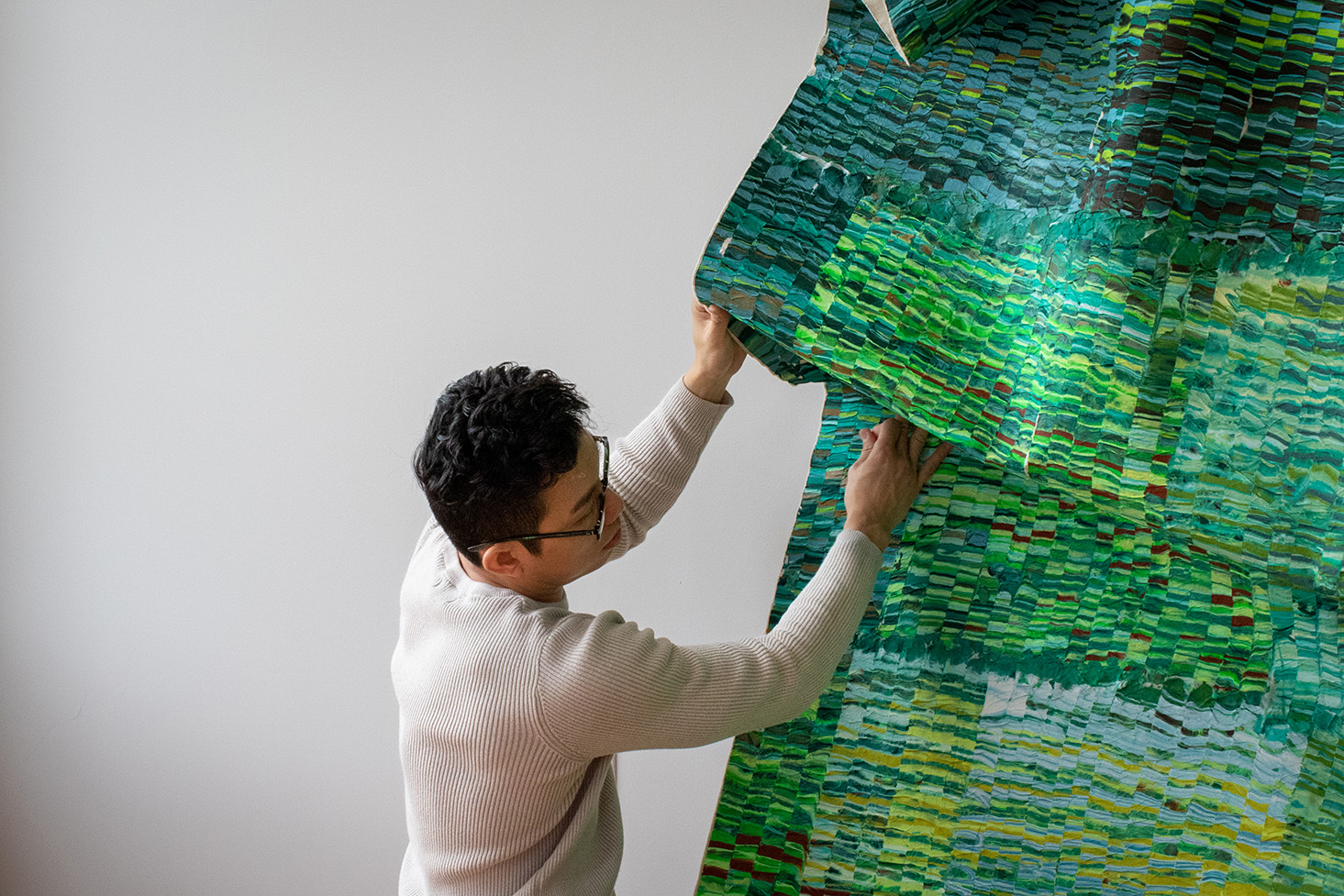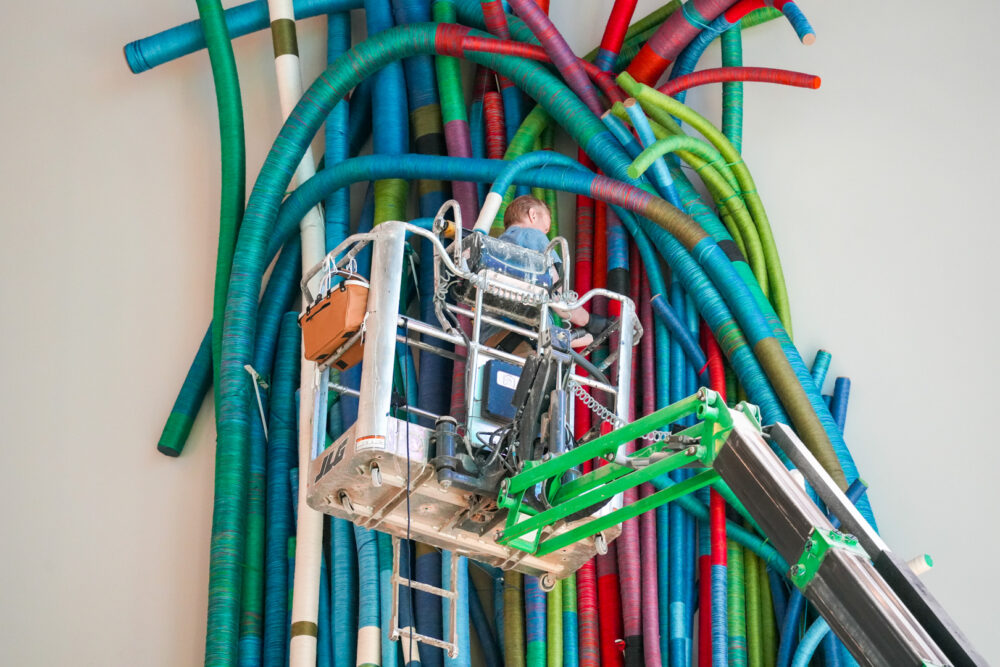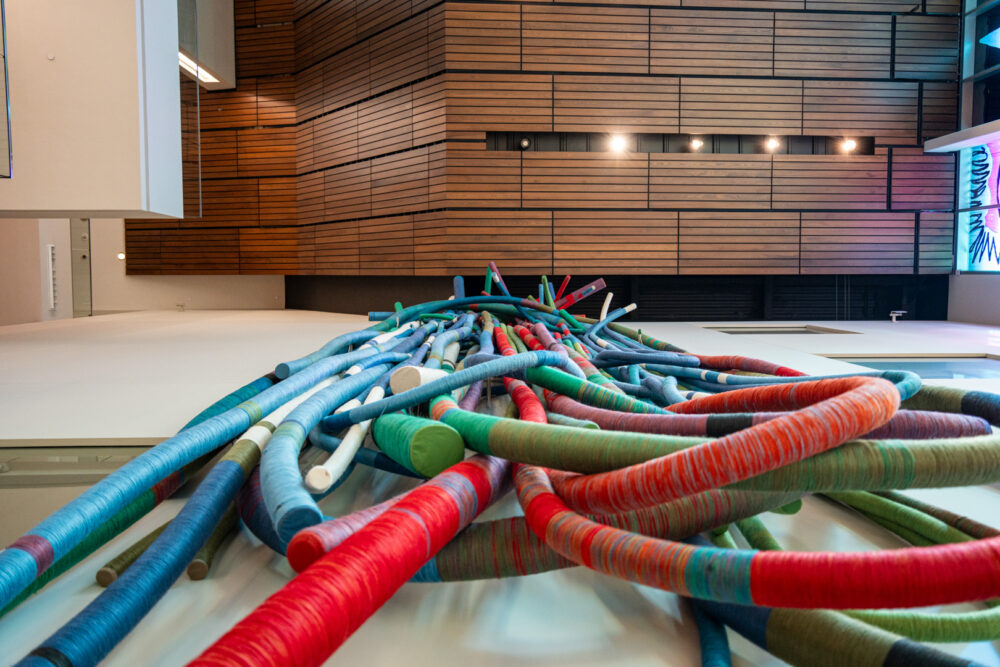
The medium is a metaphor
By Page Leggett
Kenny Nguyen is both creator and destroyer. The native of Vietnam, who now lives in Concord, explains, “If you want to do something new, you have to destroy something and rebuild it.”
His elegant, ethereal art made from paint-soaked silk looks serene. There’s no trace of the demolition involved in making it. The reason he tears down only to build back up goes deeper than aesthetics. The deconstruction (and reconstruction) mimics his own seismic cultural shift.
Nguyen and his family left Vietnam for Charlotte when he was 19. His use of silk is an homage to his homeland; Vietnam produces some of the world’s finest. Once he arrived in the United States, he felt as though he had to start everything all over again. “It was like I was being deconstructed,” he says. “I had to reconstruct my identity. If you move somewhere and don’t know anybody and don’t speak the language, it’s very isolating. I didn’t know who I was anymore.”
Portrait of the artist as a young child
Nguyen grew up in a small village in the Mekong Delta. Its size and remoteness forced him to make his own fun.
“We were very isolated,” he says. “There was no road connecting us to anything, so we traveled by boat. I didn’t have access to a playground or toys. If I wanted to play with something, I had to make it myself. My mom and dad introduced me to watercolors when I was 4 or 5, and I spent much of my childhood painting and drawing. It never left me.”
At 17, he moved to Ho Chi Minh City to study fashion design. But that wasn’t the biggest culture shock he’d experience. That happened three years later in 2010 when the family moved to Charlotte. Nguyen switched course and studied fine art, earning a bachelor’s degree in painting from UNC Charlotte in 2016. After graduation, he pursued art while also working part-time at a nail salon. The pandemic, while devastating for many, brought Nguyen good fortune. Thanks to social media, that is when he made the leap to full-time artist. Social media has no geographic boundaries, so when he shared his work online, collectors all over the world took notice. Prestigious galleries found him and he sold more in 2020 than ever before.
Nguyen is now among Sundaram Tagore Gallery’s artists, all of whom, according to the gallery’s website, “produce museum-caliber work.” The contemporary gallery, with locations in Singapore and London, specializes in “work that is aesthetically and intellectually rigorous, infused with humanism and art historically significant.” He’s exhibited in France, Iceland, and South Korea and recently returned from Büdelsdorf, Germany, where he was part of an international group show.
A melting pot of materials
There’s a lot of physicality to Nguyen’s art-making process. He creates his large-scale work on the floor of his studio. He cuts the silk and soaks the strips — often, hundreds of them — in acrylic paint. While those strips are still damp, they’re affixed to a canvas. The wet, thick paint acts as an adhesive.
The finished work has three layers: silk, paint, and canvas. Although they are tightly integrated, it is hard to tell where one piece ends and another begins. The fabric maintains its character while also becoming something new once he assembles the strips with pushpins, a holdover from his fashion design days. Once he finishes a work on the floor, he hangs it on a wall in his studio for more tinkering. The painted silk strips can be placed in different configurations on canvas. Pushpins allow him to gently sculpt the pieces into undulating folds. “One piece can take many different forms, just like our identities, which are always changing.”
Performance art
Nguyen’s collectors often tell him they have never seen anything like his art. His installation process is as labor-intensive as his creative process. It is not uncommon for a collector to film him working. One New York collector, born and raised in Vietnam, tells him it reminds her of home. “It’s always meaningful when collectors connect with my work,” he says. “These aren’t typical ready-to-hang paintings,” he explains. “My work is much more complicated. It needs to be installed. When I do an installation, it’s sort of like a performance. My collectors witness the art come alive as I rebuild it on their wall. I think it adds to the joy of collecting.”
When Nguyen invented the process he uses to make his “deconstructed paintings,” he wasn’t sure others would get it, but Sozo Gallery founder and owner Hannah Blanton did. Shortly after Nguyen’s graduation, Blanton’s now-closed uptown gallery began representing him and did so until Blanton closed Sozo and opened her art consultancy business seven years later. Today, she serves as studio director for Nguyen. Nguyen credits Blanton with promoting his work and helping explain its complexities to potential patrons.
Indeed, his work is mysterious. “People always want to take a closer look, because it’s almost an illusion tricking you,” he says.
The artist who once felt like a stranger here now considers Charlotte his second home. (Vietnam is still first.) “I’m grateful for the large art community here that encouraged and supported me,” he says. “When I talk to young people who want to start an art career here, I’m happy to tell them they don’t have to move to New York to make it.”
Page Leggett is a Charlotte-based freelance writer. Her stories have appeared in The Charlotte Observer, The Biscuit, Charlotte magazine and many other regional publications.

A reason to love the Mint? We see the worth in conservation.
The Mint Museum was awarded a grant by Bank of America to help restore artist Sheila Hicks’ work Mega Footprint Not Far from the Hutch (May I Have This Dance?).
The grant is part of the Bank of America Art Conservation Project, a global program that awards grants to nonprofit cultural institutions to conserve historically or culturally significant works of art, not least of which include works by Monet, Degas, and Cezanne; and museums like The National Gallery in London, the Guggenheim in New York and the Louvre.

This year’s recipients included 24 projects representing 11 countries — 13 United States-based projects and 11 outside the United States representing a diverse range of artistic styles, media, and cultural traditions. In July, textile conservator Howard Sutcliffe (pictured above) handled the conservation, which included cleaning and stabilizing the large textile sculpture.
To design the site-specific installation, Hicks, a United States State Department Medal of Arts award recipient, was inspired by the natural light-soaked space of the Haywood-Morrison Atrium, plus the energetic vertical sweep of the soaring ceilings, and the modernity of the building at Mint Museum Uptown. The work is comprised of 42 bas-relief sculptural components of varying lengths and thicknesses, made form flexible synthetic and cork tubes wrapped in dyed and twisted linen thread.
—Michele Huggins, Associate Director of Marketing and Communications
HB2 Squirrels shake up expectations of social norms, shine spotlight on LGBTQIA+ issues
HB2 Squirrels, a pair of gender-symbol-wielding squirrels covered in multicolored war paint greet visitors in the main entryway of Mint Museum Uptown. The squirrels, part of The Mint Museum collection, pose a striking opposition to expectations of social norms and what one expects to be met with in a museum.

Michelle Erickson. “HB2 Squirrels,” 2016, salt-glazed stoneware, porcelain slips. Museum Purchase: Funds provided by the Charles W. Beam Accessions Endowment. 2019.3a-b
The HB2 Squirrels were inspired by North Carolina’s House Bill 2, commonly referred to as the “bathroom bill.” HB2 required residents to use the bathroom in public facilities that matched the gender on their birth certificate, launching a national outcry over civil liberties. The bill was criticized for impeding the rights of transgender people and other people in the LGBTQIA+ community who do not identify strictly within the gender binary, and was later repealed by N.C. Governor Roy Cooper.
Artist Michelle Erickson, outraged, took to her potter’s wheel. The result: two salt-glazed stoneware squirrels, grasping the gender symbols—one drenched in the colors of the American flag, the other in the colors of the LGBTQIA+ rainbow flag. “Congressional acts are temporary,” she says “but art is forever.”
The composition of the squirrels also was crucial. The squirrels face each other, seemingly holding their assigned gender symbols as weapons used to fight one another. The female symbol, a circle with a cross stemming down, is inverted and held by the squirrel to mirror the way the male symbol is held. Erickson said inverting the symbol was a call to uprooting the traditional view of women as a shield.
The color of the squirrels is also indicative of the message being sent. Both have rainbow colored lines covering their face and body. Erickson said she wanted to use the rainbow motif instead of the colors of the transgender flag, to place a gentle reminder that transgender individuals are included as a part of the LGBTQIA+ community.
The squirrels also have different base bodies. The choice to make one black and one white was a conscious decision to ground it in societal tensions involving race, and to highlight the different viewpoints that stem from race within the LGBTQIA+ community.
When working with a new piece Erickson says she “allows the work to take [her.]” She starts with a design, but as the piece of clay is being shaped, it gradually takes on a new form. The overall product is as much a reflection of the process as it is the original idea.
HB2 Squirrels are a part of the past and present, she says, representing the processes of the Moravian potters, as well as speaking to the heightened political atmosphere surrounding LGBTQIA+ issues, and specifically the HB2 bill that was introduced in North Carolina in 2016. The resulting work of art challenged norms through revitalizing old processes and questioning societal implications.
The idea that became the HB2 Squirrels began as a study of a set of figural bottles from the 18th or 19th century. Erickson says the bottles originally intrigued her due to their lack of clear function and their unique construction. The bottles’ unglazed interior and overall shape indicated that they were made using a cast or mold. During her artist residency at STARworks, Erickson began using traditional techniques with salt-glazed stoneware to see if she could create a similar design. The original designs of the squirrels were modified to be reflective of the modern era.



